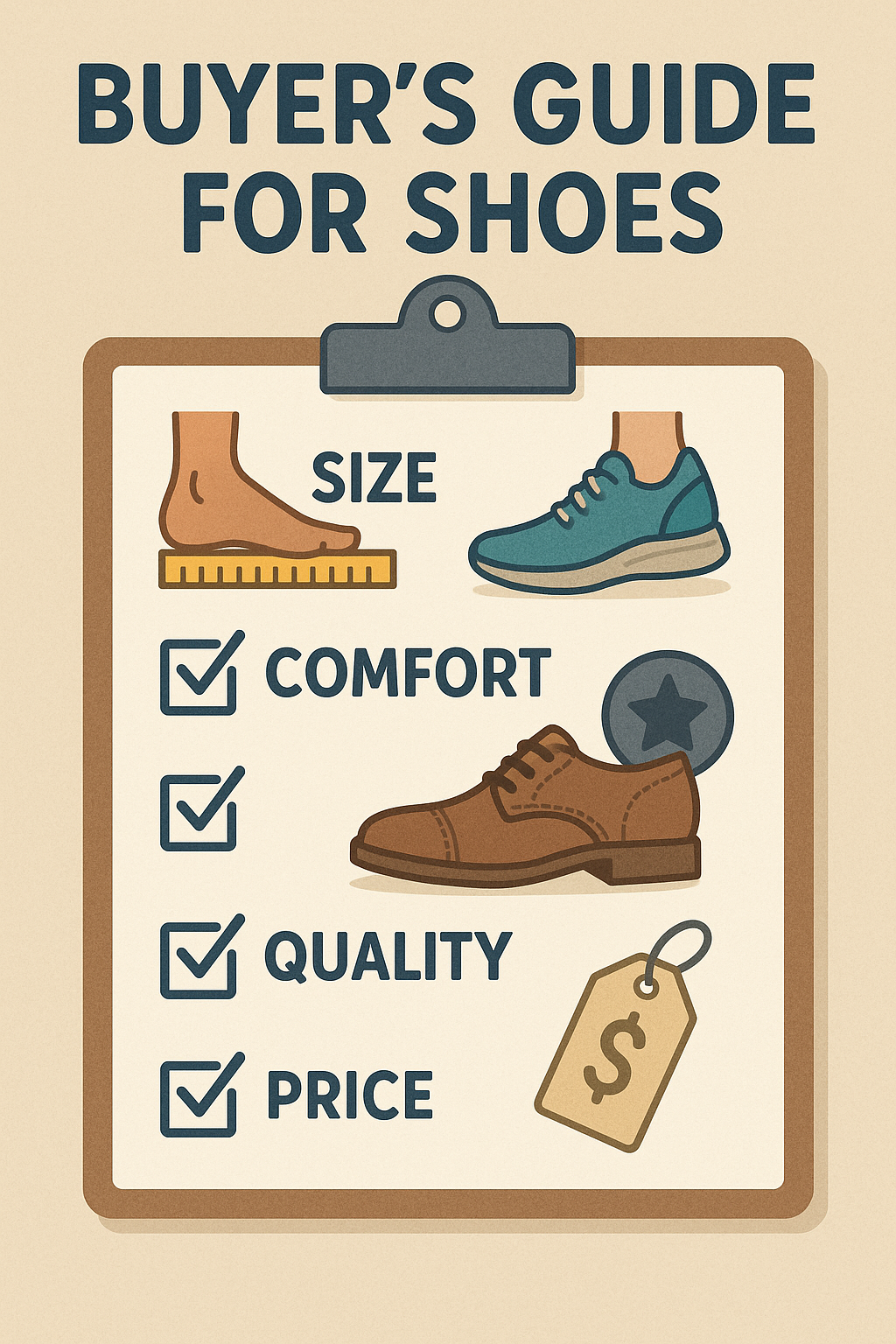Buying the perfect pair of shoes goes beyond style. Whether you’re shopping for running sneakers, formal dress shoes, or casual everyday kicks, understanding what to look for can save you from discomfort, wasted money, and even foot injuries. This comprehensive buyer’s guide for shoes will help you make informed decisions and ensure every step you take is a comfortable one.
Why Choosing the Right Shoes Matters
Shoes are more than a fashion statement—they play a crucial role in your foot health, posture, and daily comfort. Wearing the wrong pair can lead to blisters, joint pain, arch issues, and long-term musculoskeletal problems. That’s why making the right purchase is essential, especially if you wear your shoes for long hours or specific activities like sports or work.
1. Determine the Purpose of the Shoes
The first step in your shoe-buying journey is knowing why you need them. Are they for running, walking, hiking, work, or fashion? Each purpose demands different features:
- Running Shoes: Lightweight, cushioned, shock-absorbing.
- Walking Shoes: Supportive, stable, flexible soles.
- Work Shoes: Durable, slip-resistant, often steel-toed.
- Casual Shoes: Focus on comfort and style.
- Dress Shoes: Sleek, polished, often with minimal padding.
Choose a shoe that is specifically designed for the activity you plan to do most often in them.
2. Understand Your Foot Type
Your foot’s shape greatly influences the kind of shoe that will offer optimal comfort and support. Consider these factors:
a. Arch Type:
- Flat Feet: Look for motion control or stability shoes.
- Neutral Arch: Most standard shoes will work well.
- High Arch: Cushioned shoes with extra shock absorption.
b. Pronation:
Pronation refers to how your foot rolls when you walk or run. A gait analysis can determine if you overpronate (roll inward) or supinate (roll outward), which will help you choose shoes that correct and support your movement.
3. Prioritize Fit and Comfort
Never compromise on comfort. Shoes that are too tight, loose, or awkwardly shaped can cause painful issues like bunions, corns, or plantar fasciitis.
Tips for checking the fit:
- Try shoes on later in the day when your feet are slightly swollen.
- Wear the socks you intend to wear with the shoes.
- There should be about a half-inch of space between your longest toe and the shoe’s front.
- Walk around to ensure there’s no heel slippage or pinching.
4. Consider the Material
Different materials offer varying levels of durability, breathability, and flexibility.
- Leather: Durable, moldable, and stylish, but may require break-in time.
- Mesh/Fabric: Lightweight and breathable, great for sports or hot weather.
- Synthetic: Affordable and versatile but may not last as long.
The material can also impact odor, sweat absorption, and how easy the shoe is to clean.
5. Assess Sole Quality and Support
The sole is the foundation of a shoe. A good sole absorbs shock, provides grip, and supports natural movement.
What to check:
- Outsole: Should be slip-resistant and durable.
- Midsole: Offers cushioning and arch support.
- Insole: Often removable; consider orthotics if needed for additional support.
Also, check for flexibility at the toe and sturdiness at the heel.
6. Evaluate Style vs. Function
It’s easy to get swept up by trendy designs, but a stylish shoe that doesn’t fit or support your feet well will end up collecting dust—or worse, causing injury.
That said, you can find shoes that balance both aesthetics and practicality. Brands today often blend performance features with sleek designs, so take your time finding the best of both worlds.
7. Set a Realistic Budget
Shoes range from affordable basics to high-end luxury. Determine your budget ahead of time, but remember—quality is an investment. Spending a bit more upfront for better materials and craftsmanship can save you money and pain in the long run.
Avoid ultra-cheap shoes for daily wear, especially if you’ll be on your feet for extended periods.
8. Read Reviews and Brand Reputation
Before purchasing, especially online, read reviews and ratings. Look for common feedback regarding size accuracy, comfort, durability, and customer service.
Stick to brands known for specific types of shoes—like Brooks or Asics for running, Clarks for casuals, or Timberland for work boots.
9. Try Before You Buy (If Possible)
While online shopping is convenient, nothing beats trying on shoes in-store. Walk around, do a few lunges or jumps if it’s a sports shoe, and feel how they support you in action.
If you prefer online shopping:
- Check the return and exchange policies.
- Look for free returns.
- Double-check sizing charts, as they may vary by brand.
10. Take Care of Your Shoes
Even the best shoes will wear out eventually. Rotate your shoes if possible, use shoe trees, clean them regularly, and store them properly to extend their lifespan.
Frequently Asked Questions (FAQs)
Q1: How often should I replace my shoes?
A: For everyday or running shoes, replace them every 300–500 miles of use, or when you notice decreased support or visible wear on the soles.
Q2: Should I buy shoes a size bigger?
A: No, always go for a snug but comfortable fit. However, some sports shoes may recommend slightly more toe space to accommodate swelling during activity.
Q3: Are expensive shoes always better?
A: Not always. Price can indicate quality materials and design, but the best shoe is one that fits your specific foot shape and intended use.
Q4: What are the best shoes for standing all day?
A: Look for shoes with ample cushioning, arch support, and a wide toe box. Brands like HOKA, New Balance, and Skechers are popular for standing comfort.
Q5: How can I make shoes more comfortable?
A: Use cushioned insoles, break them in gradually, wear moisture-wicking socks, and ensure you’re wearing the right shoe for the activity.
Conclusion
Buying shoes is an important decision that impacts your daily life, comfort, and long-term foot health. By understanding your needs, knowing your foot type, focusing on fit and function, and doing a little research, you’ll find the perfect pair that suits your style and supports every step you take.
Use this buyer’s guide as your go-to checklist before making your next shoe purchase—and walk away satisfied every time.




Hello my friend! I wish to say that this post is amazing, nice written and include almost all vital infos. I抎 like to see more posts like this.
Good site! I truly love how it is easy on my eyes and the data are well written. I am wondering how I could be notified when a new post has been made. I have subscribed to your feed which must do the trick! Have a great day!
It抯 hard to search out educated folks on this subject, however you sound like you know what you抮e talking about! Thanks
Thanks for another excellent article. Where else could anyone get that kind of info in such a perfect way of writing? I’ve a presentation next week, and I’m on the look for such info.
Oh my goodness! a tremendous article dude. Thank you However I’m experiencing situation with ur rss . Don抰 know why Unable to subscribe to it. Is there anybody getting an identical rss problem? Anybody who knows kindly respond. Thnkx
Hey there! I could have sworn I’ve been to this website before but after reading through some of the post I realized it’s new to me. Anyhow, I’m definitely glad I found it and I’ll be book-marking and checking back frequently!
There’s noticeably a bundle to know about this. I assume you made sure nice points in features also.
Excellent post. I used to be checking continuously this weblog and I’m inspired! Extremely useful information specially the ultimate part 🙂 I handle such info much. I was seeking this particular info for a long time. Thanks and best of luck.
Thanks , I’ve recently been searching for information approximately this topic for a while and yours is the best I’ve discovered till now. However, what concerning the conclusion? Are you certain in regards to the supply?
Hello. splendid job. I did not anticipate this. This is a fantastic story. Thanks!
Very great post. I just stumbled upon your blog and wanted to say that I’ve really enjoyed surfing around your weblog posts. In any case I will be subscribing in your rss feed and I’m hoping you write again soon!
Wonderful blog! I found it while surfing around on Yahoo News. Do you have any tips on how to get listed in Yahoo News? I’ve been trying for a while but I never seem to get there! Cheers
Excellent post. I was checking constantly this blog and I am inspired! Very helpful information specially the closing phase 🙂 I maintain such info a lot. I used to be seeking this particular information for a very long time. Thanks and good luck.
Definitely, what a great website and illuminating posts, I surely will bookmark your site.Have an awsome day!